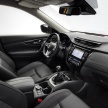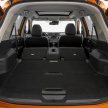VIDEO: Nissan Tsuru crash test against Versa/Almera – see how an old car compares to a modern one
Last week, we reported on the Nissan Tsuru, better known to you and me as the third-generation B13 Sentra, which will finally be discontinued next year after 25 years on the market in Mexico. The carmaker has been under pressure by Global NCAP, which has been campaigning to get the car – which has scored zero stars in Latin NCAP crash testing three years ago – removed from sale.
Now, the Insurance Institute of Highway Safety (IIHS) in the United States has released a video of crash test organised in conjunction with Global NCAP, which pitted a 2015 model year Tsuru against the latest 2016 Nissan Versa sedan – the latter is essentially the US-market version of our Almera, replete with six airbags and stability control.
The Versa isn’t even the safest car tested by IIHS; although it offered good protection in most of its tests, it received a “Poor” rating in the institute’s new small-overlap crash test, and doesn’t come with autonomous emergency braking. Yet, the video shows a stark difference in safety between a modern sedan – even a humdrum one like this – and its spiritual predecessor that was last sold in the US in 1994.
The crash test put the cars in a moderate-overlap head-to-head collision, both travelling at 40 mph (64 km/h) – resulting in a combined closing speed of 80 mph (129 km/h). While it’s undoubtedly a big impact for both these cars, the driver in the Versa would’ve been a lot better off – the car’s structure held up, and the front and curtain airbags prevented the dummy’s head from hitting any of the hard surfaces.
By contrast, the Tsuru was practically decimated by the Versa, the occupant compartment crumpling up, to pardon the rather clichéd term, like an accordion. The dashboard and steering column were pushed very far back, and with no airbags to speak of, the dummy smacked its head first on the steering wheel, then the A-pillar. Its legs would have likely been crushed, too.

Global NCAP said that a driver in the Tsuru would have had a high probability of suffering life-threatening injuries. It added that it is likely that such a crash in real world conditions would have been fatal because there were no airbags in the Tsuru and the main structures all failed, fatally compromising the survival space.
“Our first ever car-to-car test clearly shows the importance of minimum crash test regulations. Mexico doesn’t yet apply them and the US has had them for decades. The lack of standards can result in the sale of unsafe cars like the Nissan Tsuru,” Global NCAP secretary-general David Ward said.
In April this year, Latin NCAP published a report showing that the Tsuru had been involved in more than 4,000 deaths on Mexico’s roads between 2007 and 2012.
Over here, ASEAN NCAP has performed a crash test on the original Proton Saga, with similarly devastating results. You can watch the video of it below, and compare it to the video of the crash test of the latest 2016 Proton Saga below that.

